Soil/Landform Unit - Little Desert parabolic dunes
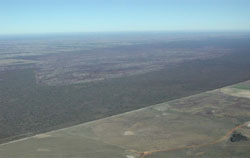 Fire scar with the parabolic dunes of south-west Little Desert |
4.54% of CMA region Within the Little Desert dunes have developed into a sequence of sand plains and jumbled dunes that are in a relatively juvenile stage of formation. The dunes comprise Lowan Sand that is thought to originate from deflation of underlying Parilla Sand as remnant stranded beach ridges. Running east-west, the Little Desert is relatively uncleared owing to the high concentration of sands and low inherent fertility. Sodic yellow and grey texture contrast soils (Sodosols) with deep sandy topsoils occur with sandy variants also prominent. Given the high concentration of sands across the dunes and plains, wind erosion is the major land degradation threat owing to the relatively incoherent nature of these sands. Shallow Sands Woodland, Sandstone Ridge Shrubland, Dunefield Heathland and Lowan Sands Mallee have been recorded on sandy soils or sandstone ridges and rises that are pronounced in the Little Desert. Other areas of remnant vegetation such as Heathy Woodland, Low Rises Woodland, Ridged Plains Mallee, Riverine Chenopod Woodland and Damp Heathland are found scattered across the landscape. | 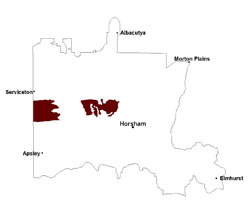 |
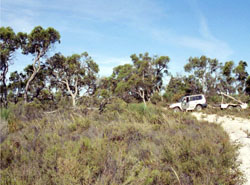 Shrubland within the parabolic dunes | 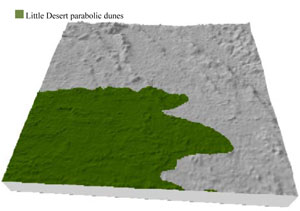 |
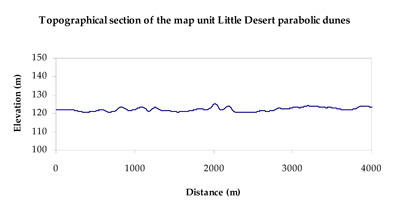 | 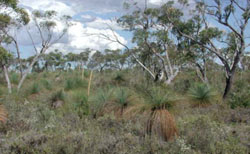 Dune slopes with Little Desert heathland/shrubland |
Component | 1 | 2 | 3 |
Proportion of soil-landform unit | 20% | 65% | 15% |
| CLIMATE Rainfall (mm) | Annual: 490 | ||
| Temperature (oC) | Minimum 8, Maximum 21 | ||
| Precipitation less than potential evapotranspiration | October–April | ||
| GEOLOGY Age and lithology | Quaternary paludal silt and clay; Neogene marine sand and silt (Parilla Sand); Quaternary aeolian dune sand (Lowan Sand) | ||
| Geomorphology | |||
| LANDUSE | Uncleared areas: Nature conservation Cleared areas: Dryland cropping; sheep grazing | ||
| TOPOGRAPHY Landscape | Parabolic dunes | ||
| Elevation range (m) | 98–188 | ||
| Local relief (m) | 10 | ||
| Drainage pattern | - | ||
| Drainage density (km/km2) | Nil | ||
| Landform | Low regular dunes | ||
| Landform element | Broad low crest | Dune slope | Sand plain |
| Slope and range (%) | 2 (0-15) | 5 (2-18) | 2 (0-6) |
| Slope shape | Convex | Convex | Straight |
| NATIVE VEGETATION Ecological Vegetation Class | Lowan Sands Mallee (28.9%), Shallow Sands Woodland (27.1%), Dunefield Heathland (12.3%), Sandstone Ridge Shrubland (12.0%), Other (19.6%) | ||
| SOIL Parent material | Aeolian sand | Aeolian sand | Aeolian sand, marine sand and silt |
| Description (Corangamite Soil Group) | Sandy soils with and without pans (31) | Sodic yellow and grey texture contrast soils (32) | Sodic yellow and grey texture contrast soils (32) |
| Soil type sites | |||
| Surface texture | Sand | Loamy sand | Loamy sand |
| Permeability | High | Slow | Slow |
| Depth (m) | > 1.5 | > 1.5 | > 1.5 |
| LAND CHARACTERISTICS, POTENTIAL AND LIMITATIONS Critical land features, processes, forms | Soils with low organic matter levels can be susceptible to wind and sheet erosion where exposed. Low inherent soil fertility. | Susceptible to wind and sheet erosion where exposed. Low inherent fertility but well drained to pans or subsoil. Susceptible to compaction where hardsetting and lower slopes occurs. | Susceptible to wind and sheet erosion where exposed. Low inherent fertility. Susceptible to compaction where hardsetting and poor drainage occurs. |


